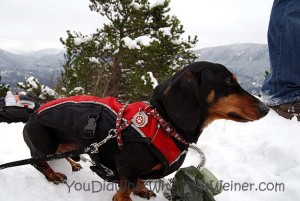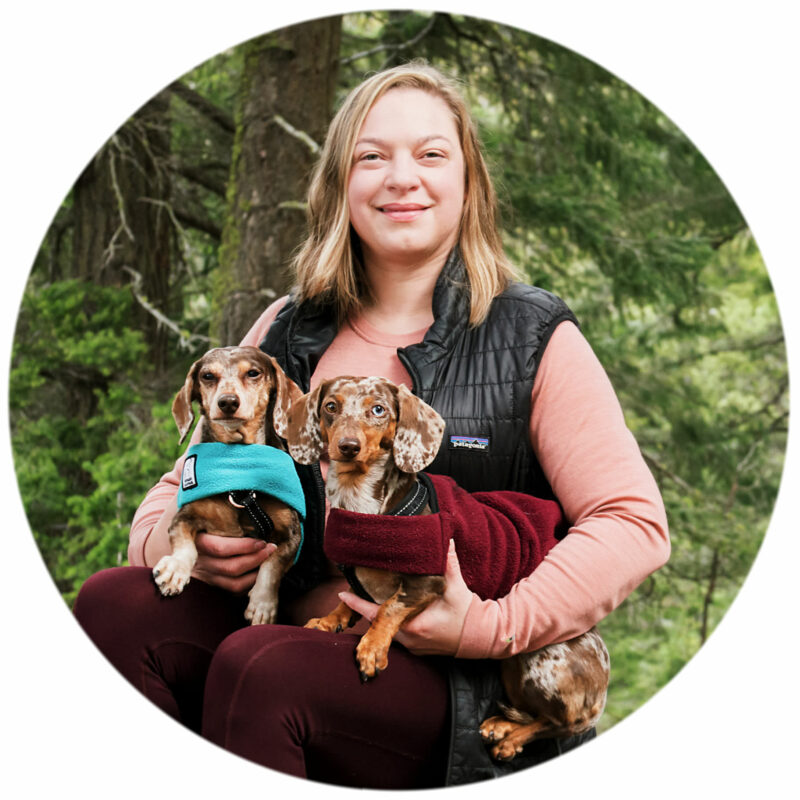Snowshoeing with Your Small Dog 101 Part VIII – Extended Trip Safety
 The subject this week is somewhat long and dry. I wrote my post on safety and then realized it was way too long for someone to read in one sitting (I am a blogger not a novelist).
The subject this week is somewhat long and dry. I wrote my post on safety and then realized it was way too long for someone to read in one sitting (I am a blogger not a novelist).
As with the previous post on short day trip safety, I tried to make a somewhat long, boring subject shorter. I also tried to infuse it will some dry humor. See if you can catch it 🙂
In Part I, I covered the basic safety stuff I bring with me for me and the dogs on short day snowshoeing trips. This second post builds on that information so be sure to go back and read it.
Bring Extra Safety Supplies
If I am going to a particularly remote location, or will be gone overnight, I also add these things extra things to my backpack.
Compass
I am horrible at determining cardinal direction and my orientation. That map I brought does me no good if I get lost so I need a compass to help me decipher it and point me in the right direction.
Real first aid kit
I mean a big one. Carrying the extra weight can suck but the deeper you get in the woods, the longer it is going to take for help to get to you. My first aid kit includes things like a soft splint, scissors, iodine, and larger bandages. I will tell you exactly what is in mine in a future post whether you are actually curious or not.
Two fire sources and fire starter
OK, seriously…good luck finding enough dry wood to burn in the snow. However, I would hate to look like an idiot if I was in an emergency situation and happened to stumble upon the biggest stack of firewood in the world so I come prepared. You always need two sources of fire in case one doesn’t work. Bring waterproof, strike anywhere matches and a lighter. You can buy fire starter at outdoor stores. It usually comes in a tube or resembles oily cotton balls.
Signaling device
You want to be able to signal for help if you are lost or hurt. Your voice may fail you but a whistle will always work. Bring one. Also bring something shiny so you can reflect the sun to catch the eye of any search planes that may be looking for you. A mirror is ideal. Most fancy compasses have one built in that you can use. Anything shiny, like tinfoil or the face of a cell phone, is better than nothing though.
Between those two lists, I have pretty much covered the 10 Essentials which is the standard emergency equipment for any hiker.
The last two piece of safety information have to do with the snowy environment itself.
Always be Aware of Avalanche Potential
If you are snowshoeing at a ski area or groomed cross country area the snowy slopes, they are either flat so the avalanche danger is very low or the slopes are avalanche controlled. Not always though so it is better to be aware of the danger to help you stay safe.
I could write a whole post (or several) about avalanche awareness but I won’t. The Forest Service operates the National Avalanche Center that has basic avalanche awareness information and lists avalanche “red flags”. There is a lot of other good information on their website so it is worth checking out.
Locally, there should be an avalanche center in your area if you regularly get snow (like in the mountains). You can search the internet for one in your area and find local avalanche forecast information there.
Here in the Washington State it is the Northwest Weather and Avalanche Center. If you click where you are going on the map it will give you a detailed avalanche forecast for the next few days in that area.
Avalanche danger is rated from 1 to 5 with 1 being low avalanche danger and 5 being extreme avalanche danger. Basically, if the danger level is a 2 or 3, don’t go unless you or someone you are with has basic avalanche awareness skills so they know what signs to look for. If it is a level 4 or 5, don’t go. It’s better so sit it out or do something else instead than end up injured or worse. someone in your group .
Most people are aware of what an avalanche is. The one important thing most people are not aware of is the danger of tree wells. What is a tree well you ask?
The Hidden Danger of Deadly Tree Wells
The website Tree Well and Deep Snow Safety describes them like this:
A tree well is a hole or depression that forms around the base of a tree. Evergreen trees (fir, hemlock, etc) can have large, deep tree wells that form when low hanging branches prohibit snow from filling in and consolidating around the base of the tree. These holes are hidden from view by the tree’s low hanging branches.”
The bottom line is stay out from underneath branches of Evergreen Trees and don’t get too close to the tree trunk. Once you fall in it is very hard to get out. The more you struggle, the more entrapped in the snow you can become. You risk suffocation, hypothermia and death. Just stay away.
I know safety is a boring topic but it’s so, so important when hiking with your dog in winter. I might argue that it’s even more important to be prepared than in the summer.

About the Author
Hi, I’m Jessica. I’ve been studying the Dachshund breed since 2007, owned 3 of my own, and shared in the lives of thousands of others through their owner’s stories. When I’m not sharing what I know on this blog, you can find me hiking, camping, and traveling with my adventurous wiener dogs.

Great post, as always. However, I think you should always have a signaling device (like a whistle) on whatever type of hike you go on, not just longer hikes.
It is never a bad idea to be more prepared. Do I honestly take one on every hike I go on though? No. Should I? Probably yes 🙂
Lots of good ideas, I’m anxious to see what’s in your first aid kit – I take a small one along, but probably need to expand. Whether it’s snow or heat you have to be prepared, too.
I have never heard of tree wells. More really good advice.
Well, They seem to primarily be an issue with evergreen trees since the needles stay on and can block the snow from falling around the tree trunk. So many people here in the northwest haven’t heard of them either though. I got stuck in one snowboarding once and it took some mad survival skills and a lot of time to get out. I was lucky but I can see how someone could easily not be. It was scary and I don’t get scared easily.
Very interesting. I’m glad you are always prepared!